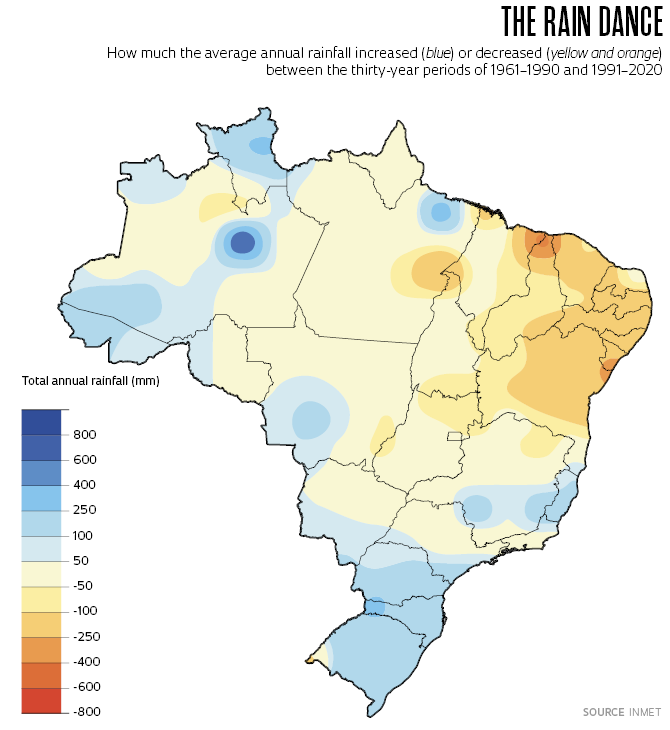Historical data and projections of the future indicate that extreme rainfall events, such as those seen along the north coast of São Paulo State during Carnival this year, which caused 65 deaths, are not a passing or localized phenomenon. They are a product of the changing climate of the twenty-first century, driven by global warming, which has caused the planet’s average temperature to rise by almost 1.2 degrees Celsius (ºC) since the 1850s. But not everyone or every part of the country faces the same risk from disasters associated with heavy storms. The risk is higher in areas where most of the population is concentrated, such as in large cities along the vast Brazilian coastline and in the South and Southeast regions, and among the poorest people who live in places more exposed to floods and landslides.
The scenario is highly complex, according to information and forecasts in the ample scientific literature on the subject, summarized in the reports of the Intergovernmental Panel on Climate Change (IPCC), the latest of which was released on March 20 of this year. The IPCC projects that as the average global temperature continues to rise, total rainfall levels will increase in much of the Brazilian territory, including in the South and Southeast, while decreasing in the Midwest, many parts of the Northeast, and in the east of the Amazon.
Sometimes, the same location can be subject to both extreme rainfall and severe droughts in different months of the same year or different years. “Most disasters in Brazil are of a hydrological or geological nature and are linked to too much or too little rain,” says climatologist José Marengo, a specialist in climate change and risk from the Brazilian Center for Natural Disaster Monitoring (CEMADEN). “That means landslides or floods, or significantly dry periods during prolonged droughts that increase the risk of fires and water shortages.”
Rainfall patterns in Brazil over the last six decades reflect this nuanced situation. Historical data compiled by Brazil’s National Meteorology Institute (Inmet) indicate that the average annual rainfall in areas located below the southern half of the states of São Paulo and Mato Grosso do Sul has increased by between 50 and 250 millimeters (mm) in the last 30 years. The only place where rainfall declined in this part of the country was a small area in the west of Rio Grande do Sul, close to the border with Uruguay and Argentina. There was also an increase in the average annual rainfall in Espírito Santo, southern Minas Gerais, southwest Mato Grosso, and some parts of the Amazon, especially in the west. Throughout the Northeast, Central Brazil and the east of the Amazon, the average annual rainfall fell (see map below). The average annual rainfall levels recorded between 1991 and 2020 differ markedly from the previous 30-year period of 1961–1990.

Since 1935, the World Meteorological Organization (WMO) has called for the adoption of climatological normals—reference values for a given weather parameter, such as the monthly or annual rainfall or the average, minimum, or maximum temperatures in a given region. The climatological normal of a parameter is calculated from the values recorded over a 30-year period. The aim is to establish a value that can be used as a point of comparison, to show whether the current climate in a certain location is changing or is behaving as expected, i.e., within the values of the most recent normal.
An increase in total rainfall of 50 or 100 mm in a city like São Paulo, which sees an average of around 1,600 mm per year, according to climatological normals, may not seem like much. But the data needs to be put into perspective. One mm of recorded rainfall is equivalent to one liter of water in an area of one square meter. An increase of 50 mm in average annual rainfall therefore means that 50 extra liters of water have fallen over the surface of a square that measures one meter by one meter. How an increase (or decrease) in rainfall is distributed over time also needs to be taken into account. In some places, the total annual precipitation may decrease, while episodes of extreme rainfall increase. “Fifty millimeters of rainfall falling in one heavy storm can generate more problems than five 10-mm episodes spread over several days,” says Inmet meteorologist Danielle Barros Ferreira.
Last year, Inmet published the results of a study that showed an increase in the number of days of heavy rainfall in three Brazilian state capitals. Since the 1990s, the city of São Paulo, the most populous in the country, has offered a good example of this trend. Based on data collected at the Mirante de Santana meteorological station, located in the north of the São Paulo state capital, an Inmet team tallied the number of days with high precipitation, with the potential to cause problems and sometimes even deaths. Days of extreme rainfall were classified as one of three levels: above 50 mm, above 80 mm, and above 100 mm.
In the past decade, more than 100 mm of rain fell in the capital of São Paulo on seven days, according to Inmet data.
In the 1960s, there were 40 days of extreme rainfall: 37 with more than 50 mm and three with more than 80 mm. The daily rainfall never exceeded 100 mm. Since the 1990s, at least 60 days of extreme rainfall have been recorded every decade. Between 2011 and 2020, an even more worrying change emerged. There was a small reduction in the number of days with rainfall greater than 50 mm, but a significant increase in the number of days with extreme rainfall at the other two levels. Comparing the results of the last decade against 2001 to 2010, there was a slight fall in the number of days with rainfall above 50 mm (from 53 to 47), but a significant increase in days with rainfall above 80 mm (from 9 to 16) and above 100 mm (from 2 to 7). “In São Paulo, torrential rain is becoming more frequent,” says Ferreira. A similar trend toward more days of extreme rainfall was also observed in two state capitals at opposite ends of the country: Belém in Pará, and Porto Alegre in Rio Grande do Sul.
The intensity of the rainfall on the north coast of São Paulo last February seems to be an outlier, even when considering current climate extremes and uncertainties. On the night of February 18, several towns in the region experienced unprecedented levels of rainfall in a period of less than 24 hours, which according to climatological normals should only occur once every 100 years. The two most illustrative cases occurred in the neighboring municipalities of Bertioga and São Sebastião, where the total expected rainfall for all of January and February fell in just 24 hours. The 683 mm of rain that fell in Bertioga was the highest ever recorded in Brazil in such a short period of time. In São Sebastião, the figure was just slightly lower, at 627 mm according to CEMADEN data.
As well as causing major physical damage and displacing around 2,000 local residents from around the north coast, 64 of the 65 deaths recorded in the region occurred in São Sebastião. More people in the town lived in dangerous areas at risk of landslides caused by the water cascading down the slopes of the Serra do Mar mountains. In Bertioga, many areas were flooded, but there were no deaths—most people live in medium- and high-quality condominiums further from the mountains.
“It was a frightening situation,” recalls Pedro Leite da Silva Dias, a meteorologist from the Institute of Astronomy, Geophysics, and Atmospheric Sciences at the University of São Paulo (IAG-USP). “I was following the formation and spread of the rain on the European Meteorological Center [ECMWF] website and from CEMADEN data until we lost electricity and internet access at around 1 a.m. on the 19th.” Dias and his wife Maria Assunção Faus da Silva Dias, also a meteorologist and now a retired IAG-USP professor, were staying at a friend’s house at a beach in São Sebastião affected by the rainfall and landslides, where fortunately nobody died.

Gustavo Basso / NurPhoto via Getty Images
Flooding in downtown São PauloGustavo Basso / NurPhoto via Getty ImagesAt the same time as an intense cold front hit southern Brazil, a small cyclone formed off the coast between the towns of Ubatuba and Paraty in the state of Rio de Janeiro, substantially increasing the intensity of the rainfall on February 18 and 19. This cyclone, which was small but disastrous, reports Dias, appeared clearly in radar images captured by CEMADEN and American satellites.
Heavy rainfall is frequent and expected in the São Sebastião region in the summer, which is the wettest season in most of the country. However, experts point out that there was a perfect and perverse synchrony that caused such heavy rainclouds to be trapped over an area of the north coast for so many hours. “Some of that rain could have fallen over the sea or other regions, but a series of factors resulted in the clouds staying in one place for a long time,” says Pedro Camarinha, a climate change and disasters specialist who works in CEMADEN’s situation room.
Some of the moisture that gathered over the north coast came from increased evaporation over the Atlantic Ocean, which was at least 1 ºC warmer than normal. To complete the picture, surface winds were blowing in a direction that interacted with the terrain of the Serra do Mar. This intensified an effect known as orographic lift, causing the formation of rainclouds for many hours. “I cannot say with absolute certainty that rainfall of this magnitude is due to global warming, but it is compatible with the phenomenon,” says Dias.
The climate situation that resulted in the tragedy was worsened by some particular aspects of São Sebastião, where much of the poor population lives in at-risk areas, close to or on the slopes of the mountains. Social inequality is high in the region and there is an absence of initiatives or plans to mitigate the effects of extreme rainfall. “For my doctoral thesis, which I defended at INPE [the Brazilian National Institute for Space Research] in 2016, I ranked the São Paulo municipalities most vulnerable to landslide-related disasters,” says Camarinha. “Taking into account multiple climatic and non-climatic factors, São Sebastião was classified as the municipality in the most critical situation both in the present and over the coming decades.”
Republish

